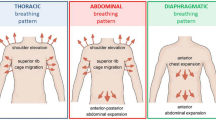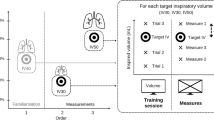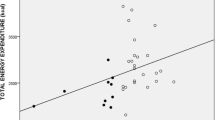Abstract
Purpose
Hypermobile Ehlers–Danlos syndrome (hEDS) is a connective tissue disorder with many different symptoms such as pain, fatigue, dysautonomia, or respiratory symptoms. Among the respiratory manifestations described, the most frequent are exertional dyspnea and breathing difficulties. Mechanical ventilatory constraints during exercise could participate in these respiratory manifestations. The objective of this study was to explore the response of pulmonary flow-volume loops to exercise in patients with hEDS and to look for dynamic hyperinflation and expiratory flow limitation during exercise.
Methods
For this purpose, breathing pattern and tidal exercise flow-volume loops were recorded at two workloads (30% and 80% of the peak power output) of a constant load exercise test.
Results
Twelve patients were included (11 women, mean age 41 ± 14 years). The results showed a decrease (p = 0.028) in the inspiratory capacity (from 3.12 ± 0.49 L to 2.97 ± 0.52 L), an increase (p = 0.025) in the end-expiratory lung volume (from 0.73 ± 0.68 L to 0.88 ± 0.66 L, i.e., from EELV comprising 17 ± 12% to 21 ± 12% of forced vital capacity) between the two workloads in favor of dynamic hyperinflation, and half of the patients had expiratory flow limitations.
Conclusion
This exploratory study provides evidence for mechanical ventilatory constraints during exercise in patients with hEDS, which may induce discomfort during exercise and could contribute to the respiratory symptomatology.
Trial registration number
This study is part of a larger clinical trial (ID: NCT04680793, December 2020).

Similar content being viewed by others
Data availability statement
The data that support the findings of this study are available from the corresponding author upon reasonable request.
Abbreviations
- CLET:
-
Constant load exercise test
- EDS:
-
Ehlers–Danlos syndrome
- EELV:
-
End-expiratory lung volume
- EFL:
-
Expiratory flow limitation
- EILV:
-
End-inspiratory lung volume
- fb :
-
Breathing frequency
- FEV1 :
-
Forced expiratory volume in one second
- FVC:
-
Forced vital capacity
- hEDS:
-
Hypermobile Ehlers–Danlos syndrome
- HR:
-
Heart rate
- IC:
-
Inspiratory capacity
- MVV:
-
Maximal voluntary ventilation
- PPO:
-
Peak power output
- RER:
-
Respiratory exchange ratio
- SpO2 :
-
Arterial oxygen saturation
- Ti :
-
Inspiratory time
- Ttot :
-
Total respiratory time
- \(\dot{V}\)CO2 :
-
Carbon dioxide output
- \(\dot{V}\) E :
-
Minute ventilation
- \(\dot{V}\)O2 :
-
Oxygen uptake
- VT :
-
Tidal volume
References
American Thoracic Society & American College of Chest Physicians (2003) ATS/ACCP Statement on cardiopulmonary exercise testing. Am J Respir Crit Care Med 167(2):211–277. https://doi.org/10.1164/rccm.167.2.211
Archiza B, Leahy MG, Kipp S, Sheel AW (2021) An integrative approach to the pulmonary physiology of exercise: when does biological sex matter? Eur J Appl Physiol 121(9):2377–2391. https://doi.org/10.1007/s00421-021-04690-9
Ayres JG, Pope FM, Reidy JF, Clark TJ (1985) Abnormalities of the lungs and thoracic cage in the Ehlers–Danlos syndrome. Thorax 40(4):300–305. https://doi.org/10.1136/thx.40.4.300
Baeza-Velasco C, Bulbena A, Polanco-Carrasco R, Jaussaud R (2019) Cognitive, emotional, and behavioral considerations for chronic pain management in the Ehlers–Danlos syndrome hypermobility-type : A narrative review. Disabil Rehabil 41(9):1110–1118. https://doi.org/10.1080/09638288.2017.1419294
Bascom R, Dhingra R, Francomano CA (2021) Respiratory manifestations in the Ehlers–Danlos syndromes. Am J Medical Genetics Part c: Seminars in Medical Genetics. https://doi.org/10.1002/ajmg.c.31953
Borg GA (1982) Psychophysical bases of perceived exertion. Med Sci Sports Exerc 14(5):377–381
Campbell SC (1982) A comparison of the maximum voluntary ventilation with the forced expiratory volume in one second: an assessment of subject cooperation. J Occupational Med: Official Publication of the Industrial Medical Association 24(7):531–533
Castori M, Camerota F, Celletti C, Danese C, Santilli V, Saraceni VM, Grammatico P (2010) Natural history and manifestations of the hypermobility type Ehlers–Danlos syndrome: a pilot study on 21 patients. Am J Med Genet A 152A(3):556–564. https://doi.org/10.1002/ajmg.a.33231
Chohan K, Mittal N, McGillis L, Lopez-Hernandez L, Camacho E, Rachinsky M, Mina DS, Reid WD, Ryan CM, Champagne KA, Orchanian-Cheff A, Clarke H, Rozenberg D (2021) A review of respiratory manifestations and their management in Ehlers–Danlos syndromes and hypermobility spectrum disorders. Chron Respir Dis 18:147997312110253. https://doi.org/10.1177/14799731211025313
De Wandele I, Rombaut L, Malfait F, De Backer T, De Paepe A, Calders P (2013) Clinical heterogeneity in patients with the hypermobility type of Ehlers–Danlos Syndrome. Res Dev Disabil 34(3):873–881. https://doi.org/10.1016/j.ridd.2012.11.018
Graham BL, Steenbruggen I, Miller MR, Barjaktarevic IZ, Cooper BG, Hall GL, Hallstrand TS, Kaminsky DA, McCarthy K, McCormack MC, Oropez CE, Rosenfeld M, Stanojevic S, Swanney MP, Thompson BR (2019) Standardization of Spirometry 2019 Update. An Official American Thoracic Society and European Respiratory Society Technical Statement. Am J Respir Critical Care Medicine 200(8):e70–e88. https://doi.org/10.1164/rccm.201908-1590ST
Guenette JA, Chin RC, Cory JM, Webb KA, O’Donnell DE (2013) Inspiratory capacity during exercise: measurement, analysis, and interpretation. Pulmonary Med 2013:1–13. https://doi.org/10.1155/2013/956081
Hakimi A, Bergoin C, Mucci P (2020) Immediate and 6-week after effects of a rehabilitation program for Ehlers–Danlos syndrome hypermobile type patients: a retrospective study. Am J Med Genet A 182(10):2263–2271. https://doi.org/10.1002/ajmg.a.61772
Hamonet C, Vienne M, Leroux C, Letinaud MP, Paumier J, Dehecq B, Metlaine A, Brock I, Bird FM (2016) Manifestations respiratoires dans le syndrome d’Ehlers-Danlos (SED) Nouveaux apports thérapeutiques. Journal De Réadaptation Médicale : Pratique Et Formation En Médecine Physique Et De Réadaptation 36(1):56–61. https://doi.org/10.1016/j.jrm.2015.11.002
Johnson BD, Weisman IM, Zeballos RJ, Beck KC (1999) Emerging concepts in the evaluation of ventilatory limitation during exercise. Chest 116(2):488–503. https://doi.org/10.1378/chest.116.2.488
Langer D, Ciavaglia CE, Neder JA, Webb KA, O’Donnell DE (2014) Lung hyperinflation in chronic obstructive pulmonary disease : mechanisms, clinical implications and treatment. Expert Rev Respir Med 8(6):731–749. https://doi.org/10.1586/17476348.2014.949676
Malfait F, Francomano C, Byers P, Belmont J, Berglund B, Black J, Bloom L, Bowen JM, Brady AF, Burrows NP, Castori M, Cohen H, Colombi M, Demirdas S, De Backer J, De Paepe A, Fournel-Gigleux S, Frank M, Ghali N, Tinkle B (2017) The 2017 international classification of the Ehlers–Danlos syndromes. Am J Med Genet C Semin Med Genet 175(1):8–26. https://doi.org/10.1002/ajmg.c.31552
Milne KM, Domnik NJ, Phillips DB, James MD, Vincent SG, Neder JA, O’Donnell DE (2020) Evaluation of dynamic respiratory mechanical abnormalities during conventional CPET. Front Med 7:548. https://doi.org/10.3389/fmed.2020.00548
Morgan AW, Pearson SB, Davies S, Gooi HC, Bird HA (2007) Asthma and airways collapse in two heritable disorders of connective tissue. Ann Rheum Dis 66(10):1369–1373. https://doi.org/10.1136/ard.2006.062224
Neder JA, Dal Corso S, Malaguti C, Reis S, De Fuccio MB, Schmidt H, Fuld JP, Nery LE (2003) The pattern and timing of breathing during incremental exercise: a normative study. Eur Respir J 21(3):530–538. https://doi.org/10.1183/09031936.03.00045402
Neder JA, Berton DC, Marillier M, Bernard A-C, O.Donnell DE (2019) The role of evaluating inspiratory constraints and ventilatory inefficiency in the investigation of dyspnea of unclear etiology. Respir Med 158:6–13. https://doi.org/10.1016/j.rmed.2019.09.007
Nourry C, Deruelle F, Fabre C, Baquet G, Bart F, Grosbois J-M, Berthoin S, Mucci P (2006) Evidence of ventilatory constraints in healthy exercising prepubescent children. Pediatr Pulmonol 41(2):133–140. https://doi.org/10.1002/ppul.20332
Quanjer PH, Stanojevic S, Cole TJ, Baur X, Hall GL, Culver BH, Enright PL, Hankinson JL, Ip MSM, Zheng J, Stocksthe ERS Global Lung Function Initiative J (2012) Multi-ethnic reference values for spirometry for the 3–95-yr age range: the global lung function 2012 equations. Eur Respir J 40(6):1324–1343. https://doi.org/10.1183/09031936.00080312
Reychler G, Liistro G, Piérard GE, Hermanns-Lê T, Manicourt D (2019) Inspiratory muscle strength training improves lung function in patients with the hypermobile Ehlers–Danlos syndrome: a randomized controlled trial. Am J Med Genet A 179(3):356–364. https://doi.org/10.1002/ajmg.a.61016
Rombaut L, De Paepe A, Malfait F, Cools A, Calders P (2010) Joint position sense and vibratory perception sense in patients with Ehlers–Danlos syndrome type III (hypermobility type). Clin Rheumatol 29(3):289–295. https://doi.org/10.1007/s10067-009-1320-y
Scheper M, Rombaut L, de Vries J, De Wandele I, van der Esch M, Visser B, Malfait F, Calders P, Engelbert R (2017) The association between muscle strength and activity limitations in patients with the hypermobility type of Ehlers–Danlos syndrome: the impact of proprioception. Disabil Rehabil 39(14):1391–1397. https://doi.org/10.1080/09638288.2016.1196396
Sulli A, Talarico R, Scirè CA, Avcin T, Castori M, Ferraris A, Frank C, Grunert J, Paolino S, Bombardieri S, Schneider M, Smith V, Cutolo M, Mosca M, Malfait F (2018) Ehlers–Danlos syndromes : State of the art on clinical practice guidelines. RMD Open 4(Suppl 1):e000790. https://doi.org/10.1136/rmdopen-2018-000790
Sun X-G, Hansen JE, Garatachea N, Storer TW, Wasserman K (2002) Ventilatory efficiency during exercise in healthy subjects. Am J Respir Crit Care Med 166(11):1443–1448. https://doi.org/10.1164/rccm.2202033
Syx D, De Wandele I, Rombaut L, Malfait F (2017) Hypermobility, the Ehlers–Danlos syndromes and chronic pain. Clin Experimental Rheumatol 107(5):116–122
Tanaka H, Monahan KD, Seals DR (2001) Age-predicted maximal heart rate revisited. J Am Coll Cardiol 37(1):153–156. https://doi.org/10.1016/s0735-1097(00)01054-8
Tinkle B, Castori M, Berglund B, Cohen H, Grahame R, Kazkaz H, Levy H (2017) Hypermobile Ehlers–Danlos syndrome (a.k.a. Ehlers–Danlos syndrome Type III and Ehlers–Danlos syndrome hypermobility type): clinical description and natural history. Am J Med Genetics Part c: Seminars in Medical Genetics 175(1):48–69. https://doi.org/10.1002/ajmg.c.31538
van’t Hul A, Gosselink R, Kwakkel G (2003) Constant-load cycle endurance performance : test-retest reliability and validity in patients with COPD. J Cardiopulmonary Rehabilitation 23(2):143–150. https://doi.org/10.1097/00008483-200303000-00012
Wasserman K (2005) Principles of exercise testing and interpretation: Ncluding pathophysiology and clinical applications. Lippincott Williams & Wilkins, Philadelphia
Acknowledgements
The authors would like to thank the patients who agreed to participate in this study and the entire staff of the Clinique de la Mitterie.
Funding
The authors did not receive support from any organization for the submitted work.
Author information
Authors and Affiliations
Contributions
AH, CB, and PM contributed to the design and implementation of the research, to the analysis of the results, and to the writing of the manuscript.
Corresponding author
Ethics declarations
Conflicts of interest
The authors have no relevant financial or non-financial interests to disclose.
Ethical approval
This study is part of a clinical trial that has been approved by a national ethics committee (CPP Ile de France IV, 2019/71). All patients were volunteers and gave their informed consent.
Additional information
Communicated by Susan Hopkins.
Publisher's Note
Springer Nature remains neutral with regard to jurisdictional claims in published maps and institutional affiliations.
Rights and permissions
Springer Nature or its licensor holds exclusive rights to this article under a publishing agreement with the author(s) or other rightsholder(s); author self-archiving of the accepted manuscript version of this article is solely governed by the terms of such publishing agreement and applicable law.
About this article
Cite this article
Hakimi, A., Bergoin, C. & Mucci, P. Evidence of ventilatory constraints during exercise in hypermobile Ehlers–Danlos syndrome. Eur J Appl Physiol 122, 2367–2374 (2022). https://doi.org/10.1007/s00421-022-05017-y
Received:
Accepted:
Published:
Issue Date:
DOI: https://doi.org/10.1007/s00421-022-05017-y




